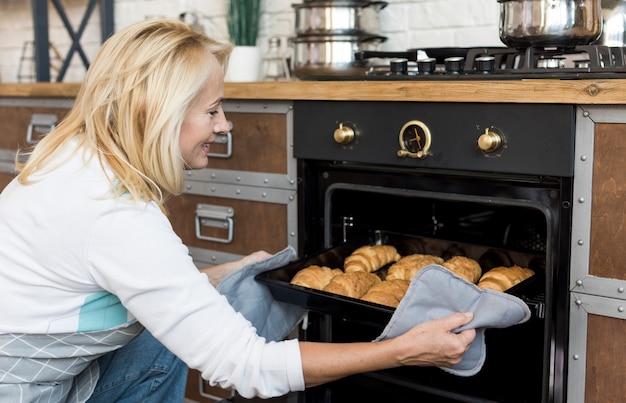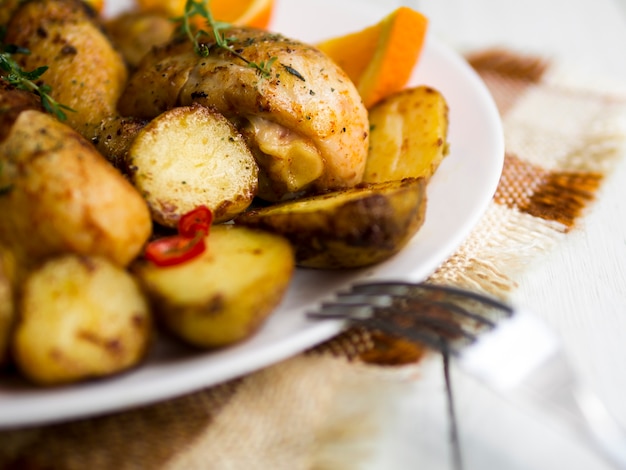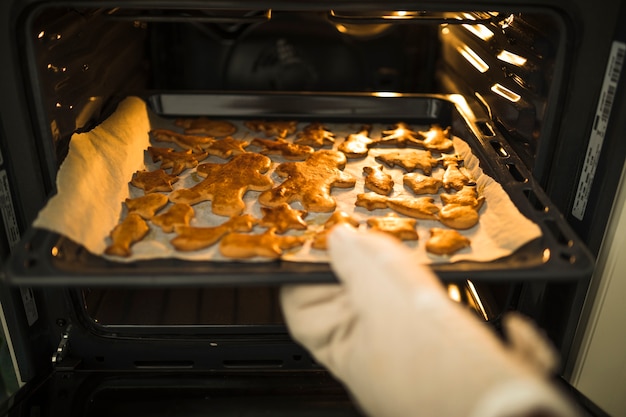There's something undeniably comforting about a baked potato. It's a humble dish, but one that can be elevated to culinary greatness with the right approach. Whether you're a seasoned chef or a kitchen novice, mastering the art of baking the perfect potato is a skill worth acquiring.
Over the years, I've experimented with various methods and discovered a few key secrets to consistently achieving that fluffy, golden-brown spud. In this guide, I'll share my insights, drawing on personal experiences and anecdotes to make this journey engaging and informative.
(Part 1) The Science Behind a Perfectly Baked Potato

Before we delve into the nitty-gritty of baking, let's unravel the science behind the magic. It's all about understanding the potato's internal workings - the starch granules, to be precise.
Starch Granules: The Fluffy Factor
Imagine those starch granules as tiny sponges. When heated, they absorb water and swell, creating that airy, fluffy texture we all crave. The type of potato you choose plays a crucial role in this process. Potatoes with a higher starch content, like the classic king edward, are naturally more prone to fluffiness.
Moisture Management: A Balancing Act
Moisture is equally important. Think of it like a delicate dance: too much, and you'll end up with a soggy mess. Too little, and your potato will be dry and crumbly. This is where oven temperature and time come into play, along with a crucial technique: pricking.
Oven Temperature: Finding the Sweet Spot
You want your oven to be hot enough to cook the potato through without burning the outside. A temperature of around 200°C (400°F) is ideal. Too low, and you risk a sluggish bake, leading to a less-than-desirable texture.
Baking Time: A Question of Size
The baking time depends on the size of your potato. A small potato might be ready in 45 minutes, while a large one could take an hour or even longer. The key is to check for doneness, and that's where our trusty skewer comes in.
The Art of Pricking: Preventing Explosions
Ever wondered why seasoned cooks prick their potatoes before baking? It's not just a whimsical ritual. Pricking those tiny holes allows steam to escape, preventing the potato from exploding in the oven. Think of it as a safety valve for your starchy friend.
(Part 2) choosing the right potato

Now, let's talk about the heart of the matter: choosing the right potato for baking. It's not just any spud that will do, you know.
King Edward: The Fluffy Champion
For me, the King Edward reigns supreme. Its high starch content yields that wonderfully fluffy, light texture that's perfect for loaded baked potatoes. It's got a mild flavour and a creamy consistency that just melts in your mouth.
maris piper: A Versatile All-Rounder
Maris Piper is another popular choice, a bit more versatile than King Edward. It's excellent for roasting, mashing, and yes, baking too. While it might not have the same ethereal fluffiness as King Edward, it bakes up beautifully, with a satisfyingly firm texture and a good flavour.
Beyond the Classics: Exploring Other Options
Don't be afraid to experiment! Other potatoes can work well for baking, offering different textures and flavours.
- Desiree: This potato delivers a slightly waxy texture, offering a different take on the classic baked potato experience.
- Pink Fir Apple: While this potato is renowned for roasting, it also excels as a baking potato, bringing a hint of sweetness and nuttiness to the table.
(Part 3) Preparing the Potatoes: A Step-by-Step Guide

Now, it's time to get our hands dirty and prepare those potatoes for their oven rendezvous. Here's my step-by-step guide:
1. Scrubbing Away the Dirt: A Clean Slate
The first step is to give those potatoes a good scrub under running water using a vegetable brush. You want to remove any dirt or grime clinging to the skin. A clean potato is a happy potato.
2. Pricking with Precision: Releasing the Steam
Grab a fork or a skewer and give those potatoes a good pricking. The goal is to create enough holes to allow steam to escape during baking, ensuring even cooking and preventing those dreaded explosions.
3. Foil Wrapping: Optional but Beneficial
This step is optional, but I highly recommend it. Wrapping each potato in foil helps to trap moisture and steam, leading to a more tender and fluffy potato. Make sure the foil is tightly sealed around the potato to maximize its steaming power.
(Part 4) Baking Time: The Heat Is On
With our potatoes prepped and ready, it's time to unleash the oven's magic.
1. Preheat to Perfection: Setting the Stage
Preheat your oven to 200°C (400°F). This ensures that your potatoes bake evenly and efficiently. It's all about getting that consistent heat distribution for optimal results.
2. Arranging for Space: A Comfortable Bake
Place your potatoes on a baking sheet. Don't overcrowd them. Give them some space to breathe and cook evenly.
3. Baking Time: Patience is Key
Now, the moment of truth. Pop those potatoes into the preheated oven and bake for 45-60 minutes. The exact baking time will depend on the size of your potatoes.
After 45 minutes, check the potatoes with a skewer. If it goes in easily and comes out clean, they're ready. If not, bake for another 5-10 minutes and check again.
(Part 5) The Great Potato Test: Knowing When It's Done
As those potatoes bake, you'll be eager to know when they're ready. There are a few foolproof methods to ensure you don't overcook or undercook your spuds.
1. The Skewer Test: The Classic Approach
This is my go-to method. Insert a skewer into the centre of the potato. If it goes in easily and comes out clean, it's done. If you encounter resistance, it needs a few more minutes in the oven.
2. The Squeeze Test: A Firm Hand, a Perfect Potato
Gently squeeze the potato. If it feels firm and springy, you're good to go. If it feels soft and mushy, it might need a little more time.
3. The Visual Test: Signs of a Cooked Potato
If the skin of the potato is slightly browned and looks dry, it's likely cooked through. This is a good visual indicator, but always combine it with the other tests to be sure.
(Part 6) The Ultimate potato toppings: A Flavor Symphony
Your potato is baked to perfection. Now, it's time for the grand finale: the toppings! The world of baked potato toppings is vast and varied, offering a canvas for your culinary creativity.
Classic Combinations: Tried and True
- Butter and Salt: The simplest, yet most satisfying. A touch of melted butter enhances the potato's natural flavour, while a sprinkle of salt brings out the earthy notes.
- Sour Cream and Chives: A tangy and refreshing combination that adds a delightful layer of complexity to the potato. The sour cream provides a cool contrast to the warm potato, while the chives offer a subtle herbal aroma.
- Cheese and Bacon: Indulgent and delicious, this pairing is a crowd-pleaser. The salty bacon complements the creamy cheese, creating a symphony of flavour that's hard to resist.
Creative Variations: Beyond the Ordinary
Feel free to experiment and explore beyond the classics. Here are a few ideas to spark your imagination:
- BBQ Pulled Pork: A smoky and savory topping that will take your baked potato to a whole new level of deliciousness.
- Chili: A hearty and satisfying choice, perfect for a chilly evening.
- Tuna Mayo: A light and refreshing option for those seeking a lighter meal.
- Roasted Vegetables: A vibrant and healthy topping that adds colour and texture to your potato.
- Avocado and Lime: A creamy and tangy combination that's both delicious and nutritious.
- Guacamole and Salsa: A vibrant and flavourful topping for a taste of Mexico.
- Sautéed Mushrooms and Onions: A classic pairing that elevates the potato to new heights.
(Part 7) Tips and Tricks: Mastering the Baked Potato
Over the years, I've picked up a few tricks of the trade that have helped me consistently bake perfect potatoes. Here are some valuable insights to enhance your baking journey.
1. For Extra crispy skin: Embrace the Open Air
If you're craving that crispy, golden-brown skin, skip the foil wrapping. Let those potatoes bake uncovered. The direct heat from the oven will encourage browning and create a delightful crunch.
2. Maximizing Fluffiness: Let It Rest
After baking, let your potatoes rest for a few minutes before cutting them open. This allows the steam to escape, leading to a fluffier interior. It's a simple yet effective technique for achieving that airy texture.
3. Avoiding Soggy Disasters: Don't Overbake
Don't overbake your potatoes. They should be tender and cooked through, but not mushy. The key is to stop baking when they reach that perfect balance between tenderness and firmness.
4. Make-Ahead Magic: Plan Ahead for Deliciousness
Bake your potatoes ahead of time and store them in the refrigerator. They’ll last for a few days and can be reheated in the oven or microwave. This is a great time-saving tip for busy weeknights.
(Part 8) baked potato variations: Beyond the Classic
Baked potatoes aren't just for topping, you know. They can be transformed into a variety of delicious dishes. Here are a few ideas to get your creative juices flowing:
Potato Skins: A Crispy Snack
Cut the potato in half, scoop out the flesh, and bake until the skin is crispy. Then fill the skins with your favourite toppings for a tasty snack or appetizer.
potato salad: A Creamy Classic
Dice the baked potato and combine it with your favourite salad ingredients, such as mayonnaise, mustard, onions, and celery. This classic side dish is always a hit.
potato soup: A Hearty Comfort
Use baked potatoes as a base for a creamy and comforting soup. Add broth, milk, and your favourite vegetables and spices for a delicious and satisfying meal.
(Part 9) FAQs: Answering Your Baked Potato Queries
Here are answers to some common questions about baking potatoes:
1. How long does it take to bake a potato in the oven?
The baking time depends on the size of the potato. Generally, it takes around 45-60 minutes at 200°C (400°F). It's always best to check the potato with a skewer to ensure it's cooked through.
2. What happens if I don't prick the potato before baking?
If you don’t prick the potato, it’s likely to explode in the oven. The steam will have nowhere to escape, and the pressure will build up, causing the potato to burst.
3. Can I bake potatoes in the microwave?
Yes, you can bake potatoes in the microwave. However, they won’t have the same texture as oven-baked potatoes. Microwave baking will result in a softer, less crispy potato.
4. How do I store baked potatoes?
Store baked potatoes in the refrigerator for up to 3 days. To reheat, place them in the oven or microwave.
5. What are some good toppings for baked potatoes?
The possibilities are endless! Some popular toppings include butter and salt, sour cream and chives, cheese and bacon, pulled pork, chili, and tuna mayo. It’s really up to your personal preference.
(Part 10) The Joy of a perfect baked potato: Simple Pleasures
There's a reason baked potatoes have been a culinary staple for centuries. They're simple, comforting, and endlessly versatile. It's a dish that can be enjoyed by everyone, from children to adults, and it always feels like a little bit of home.
So, the next time you're craving something delicious and easy, give baking a potato a try. It's a journey worth taking, and you'll be rewarded with a perfect spud that's sure to please.
Everyone is watching

Perfect Rice Every Time: The Ultimate Guide to Cooking Rice
Cooking TipsAs a self-proclaimed foodie, I've always been a bit obsessed with rice. It's the foundation of countless cuisi...

Prime Rib Roast Cooking Time Chart: Per Pound Guide
Cooking TipsPrime rib roast. Just the name conjures images of lavish dinners, crackling fires, and hearty laughter. It’s ...

The Ultimate Guide to Cooking Asparagus: Tips, Techniques, and Recipes
Cooking TipsAsparagus. The mere mention of this spring delicacy conjures up images of vibrant green spears, crisp and burs...

Ultimate Guide to Cooking the Perfect Thanksgiving Turkey
Cooking TipsThanksgiving. Just the word conjures up images of overflowing tables laden with delicious food, the scent of r...

How Long to Bake Potatoes in the Oven (Perfect Every Time)
Cooking TipsBaked potatoes are a staple in my kitchen. They're incredibly versatile, delicious, and surprisingly easy to m...
